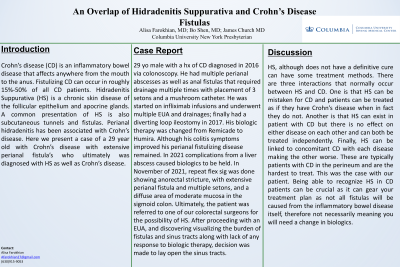Sunday Poster Session
Category: IBD
P0797 - An Overlap of Hidradenitis Suppurativa and Crohn’s Disease Fistulas
Sunday, October 22, 2023
3:30 PM - 7:00 PM PT
Location: Exhibit Hall

Has Audio
- AF
Alisa Farokhian, MD
Columbia University
New York, NY
Presenting Author(s)
Alisa Farokhian, MD, Bo Shen, MD, James Church, MD
Columbia University, New York, NY
Introduction: Crohn’s disease (CD) is an inflammatory bowel disease that affects anywhere from the mouth to the anus. Fistulizing CD can occur in roughly 15%-50% of all CD patients. Hidradenitis Suppurativa (HS) is a chronic skin disease of the follicular epithelium and apocrine glands. A common presentation of HS is also subcutaneous tunnels and fistulas. Perianal hidradenitis has been associated with Crohn’s disease. Here we present a case of a 29 year old with Crohn’s disease with extensive perianal fistula’s who ultimately was diagnosed with HS as well as Crohn’s disease.
Case Description/Methods: 29 yo male with a hx of CD diagnosed in 2016 via colonoscopy. He had multiple perianal abscesses as well as anal fistulas that required drainage multiple times with placement of 3 setons and a mushroom catheter. He was started on infliximab infusions and underwent multiple EUA and drainages; finally had a diverting loop ileostomy in 2017. His biologic therapy was changed from Remicade to humira. Although his colitis symptoms improved his perianal fistulizing disease remained. In 2021 complications from a liver abscess caused biologics to be held. In November of 2021, repeat flex sig was done showing anorectal stricture, with extensive perianal fistula and multiple setons, and a diffuse area of moderate mucosa in the sigmoid colon. Ultimately, the patient was referred to one of our colorectal surgeons for the possibility of HD. After proceeding with an EUA, and discovering visualizing the burden of fistulas and sinus tracts along with lack of any response to biologic therapy, decision was made to lay open the sinus tracts.
Discussion: HD, although does not have a definitive cure can have some treatment methods. There are three interactions that normally occur between HA and CD. One is that HA can be mistaken for CD and patients can be treated as if they have Crohn’s disease when in fact they do not. Another is that HA can exist in patient with CD but there is no effect on either disease on each other and can both be treated independently. Finally, HA can be linked to concomitant CD with each disease making the other worse. These are typically patients with CD in the perineum and are the hardest to treat. This was the case with our patient. Being able to recognize HD in CD patients can be crucial as it can gear your treatment plan as not all fistulas will be caused from the inflammatory bowel disease itself, therefore not necessarily meaning you will need a change in biologics.
Disclosures:
Alisa Farokhian, MD, Bo Shen, MD, James Church, MD. P0797 - An Overlap of Hidradenitis Suppurativa and Crohn’s Disease Fistulas, ACG 2023 Annual Scientific Meeting Abstracts. Vancouver, BC, Canada: American College of Gastroenterology.
Columbia University, New York, NY
Introduction: Crohn’s disease (CD) is an inflammatory bowel disease that affects anywhere from the mouth to the anus. Fistulizing CD can occur in roughly 15%-50% of all CD patients. Hidradenitis Suppurativa (HS) is a chronic skin disease of the follicular epithelium and apocrine glands. A common presentation of HS is also subcutaneous tunnels and fistulas. Perianal hidradenitis has been associated with Crohn’s disease. Here we present a case of a 29 year old with Crohn’s disease with extensive perianal fistula’s who ultimately was diagnosed with HS as well as Crohn’s disease.
Case Description/Methods: 29 yo male with a hx of CD diagnosed in 2016 via colonoscopy. He had multiple perianal abscesses as well as anal fistulas that required drainage multiple times with placement of 3 setons and a mushroom catheter. He was started on infliximab infusions and underwent multiple EUA and drainages; finally had a diverting loop ileostomy in 2017. His biologic therapy was changed from Remicade to humira. Although his colitis symptoms improved his perianal fistulizing disease remained. In 2021 complications from a liver abscess caused biologics to be held. In November of 2021, repeat flex sig was done showing anorectal stricture, with extensive perianal fistula and multiple setons, and a diffuse area of moderate mucosa in the sigmoid colon. Ultimately, the patient was referred to one of our colorectal surgeons for the possibility of HD. After proceeding with an EUA, and discovering visualizing the burden of fistulas and sinus tracts along with lack of any response to biologic therapy, decision was made to lay open the sinus tracts.
Discussion: HD, although does not have a definitive cure can have some treatment methods. There are three interactions that normally occur between HA and CD. One is that HA can be mistaken for CD and patients can be treated as if they have Crohn’s disease when in fact they do not. Another is that HA can exist in patient with CD but there is no effect on either disease on each other and can both be treated independently. Finally, HA can be linked to concomitant CD with each disease making the other worse. These are typically patients with CD in the perineum and are the hardest to treat. This was the case with our patient. Being able to recognize HD in CD patients can be crucial as it can gear your treatment plan as not all fistulas will be caused from the inflammatory bowel disease itself, therefore not necessarily meaning you will need a change in biologics.
Disclosures:
Alisa Farokhian indicated no relevant financial relationships.
Bo Shen: Abvie – Consultant. Takeda – Consultant.
James Church indicated no relevant financial relationships.
Alisa Farokhian, MD, Bo Shen, MD, James Church, MD. P0797 - An Overlap of Hidradenitis Suppurativa and Crohn’s Disease Fistulas, ACG 2023 Annual Scientific Meeting Abstracts. Vancouver, BC, Canada: American College of Gastroenterology.
